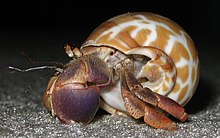Land Hermit Crabs
| Land Hermit Crabs | ||||||||||||
|---|---|---|---|---|---|---|---|---|---|---|---|---|

Coenobita clypeatus on the beach in Mexico |
||||||||||||
| Systematics | ||||||||||||
|
||||||||||||
| Scientific name | ||||||||||||
| Coenobitidae | ||||||||||||
| Dana , 1851 |
Land hermit crabs (Coenobitidae) are completely adapted to life on land, except for the larval stage. They live in humid, tropical regions of the world by the sea and near the beach, such as B. in the Indo-Pacific on coral islands.
features
Land hermit crabs seem to be "left-sheared" throughout. So there is a “ division of labor ” between the right and left scissors . They share this characteristic with the species of the left-handed hermit crabs (Diogenidae).
Way of life
The species of terrestrial hermit crabs live on land in different terrestrial habitats . Many of the inhabited biotopes are located near the shore on beaches, in mangrove areas or coastal rainforests . Others, however, include grasslands and dry deciduous forests up to 900 meters above sea level and up to 15 kilometers inland. The crabs visit fresh water sources at regular intervals and meet their water needs there.
Once a year the migration to the seashore begins. Often a large number of land hermit crabs migrate simultaneously, controlled by the phases of the moon and the tides .
The females carry eggs attached to the underside of the abdomen to the seashore, where the Zoea larvae hatch. These are dependent on life in the sea water and complete their development as part of the plankton . They develop into small crabs, look for snail shells and then leave the sea as subadult land hermit crabs to live on land.
Since land hermit crabs are omnivores, their diet consists of fruits and plants, but also of carrion . They are predominantly nocturnal and withdraw into their protective housing at the slightest disturbance.
Internal system
The land hermit crab family consists of two genera . There are 17 species in the genus Coenobita . The genus Birgus is monotypical . The only species, the palm thief ( Birgus latro ), is not only the largest terrestrial hermit crab , but also the largest land-based crustacean on earth.
-
Coenobita Latreille, 1829
- Coenobita brevimanus Dana, 1852
- Coenobita carnescens Dana, 1851
- Coenobita cavipes Stimpson, 1858
- Coenobita clypeatus (JC Fabricius, 1787)
- Coenobita compressus H. Milne Edwards, 1836
- Coenobita longitarsis de Man, 1902
- Coenobita olivieri Owen, 1839
- Coenobita perlatus H. Milne Edwards, 1837
- Coenobita pseudorugosus Nakasone, 1988
- Coenobita purpureus Stimpson, 1858
- Coenobita rubescens Greeff, 1884
- Coenobita rugosus H. Milne Edwards, 1837
- Coenobita scaevola (Forskål, 1775)
- Coenobita spinosus H. Milne Edwards, 1837
- Coenobita variabilis McCulloch, 1909
- Coenobita violascens Heller, 1862
- Coenobita purple Rahayu, Shih & Ng, 2016
-
Birgus WE Leach, 1815
- Palm thief ( Birgus latro Linnaeus, 1767)
Individual evidence
- ↑ Wataru Doi, Akira Mizutani & Hiroyoshi Kohno: Larval release and associated tree-climbing behavior of the land hermit crab Coenobita violascens Heller, 1862 (Anomura: Coenobitidae) . Journal of Crustacean Biology, pp. 1-8, Brill, 2016 doi : 10.1163 / 1937240X-00002427
- ^ Hans-Eckhard Gruner: Class Crustacea - crustaceans. In: Horst Füller et al .: Urania Tierreich. Volume Verbellose Tiere 2, Leipzig 1994, page 511, ISBN 3-332-00502-2
- ^ P. McLaughlin: Coenobita Latreille, 1829 . In: R. Lemaitre, P. McLaughlin: World Paguroidea & Lomisoidea database . Accessed through: World Register of Marine Species, 2015, accessed April 2, 2016
- ↑ A new species of land hermit crab in the genus Coenobita Latreille, 1829 from Singapore, Malaysia and Indonesia, previously confused with C. cavipes Stimpson, 1858 (Crustacea: Decapoda: Anomura: Coenobitidae)
Web links
- Video: Coenobita scaevola (Paguridae) - Movements and moving house in the field . Institute for Scientific Film (IWF) 1963, made available by the Technical Information Library (TIB), doi : 10.3203 / IWF / E-489 .
